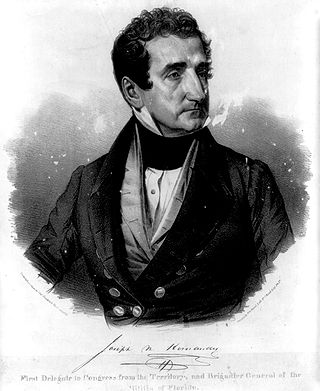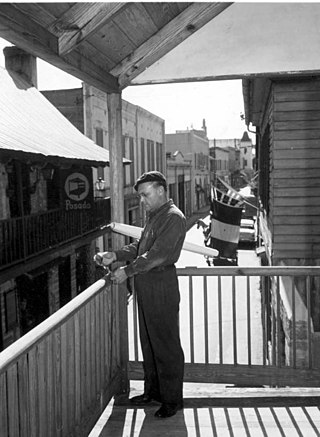
St. Augustine is a city in and the county seat of St. Johns County located 40 miles south of downtown Jacksonville. The city is on the Atlantic coast of northeastern Florida. Founded in 1565 by Spanish explorers, it is the oldest continuously inhabited European-established settlement in what is now the contiguous United States.

New Smyrna Beach is a city in Volusia County, Florida, United States, located on the central east coast of the state, with the Atlantic Ocean to the east. The downtown section of the city is located on the west side of the Indian River and the Indian River Lagoon system. The Coronado Beach Bridge crosses the Intracoastal Waterway just south of Ponce de Leon Inlet, connecting the mainland with the beach on the coastal barrier island. Its population is 30,142 in 2020 by the United States Census Bureau.

East Florida was a colony of Great Britain from 1763 to 1783 and a province of the Spanish Empire from 1783 to 1821. The British gained control over Spanish Florida in 1763 as part of the Treaty of Paris that ended the Seven Years' War. Deciding that the colony was too large to administer as a single unit, British officials divided Florida into two colonies separated by the Apalachicola River; the colony of East Florida, with its capital located in St. Augustine and West Florida, with its capital located in Pensacola. East Florida was much larger and comprised the bulk of the former Spanish colony and most of the current state of Florida. It had also been the most populated region of Spanish Florida, but before control was transferred to Britain, most residents – including virtually everyone in St. Augustine – left the territory, with most migrating to Cuba.

Spanish Florida was the first major European land-claim and attempted settlement-area in northern America during the European Age of Discovery. La Florida formed part of the Captaincy General of Cuba, the Viceroyalty of New Spain, and the Spanish Empire during Spanish colonization of the Americas. While its boundaries were never clearly or formally defined, the territory was initially much larger than the present-day state of Florida, extending over much of what is now the southeastern United States, including all of present-day Florida plus portions of Georgia, South Carolina, North Carolina, Alabama, Mississippi, and the Florida Parishes of Louisiana. Spain based its claim to this vast area on several wide-ranging expeditions mounted during the 16th century. A number of missions, settlements, and small forts existed in the 16th and to a lesser extent in the 17th century; they were eventually abandoned due to pressure from the expanding English and French colonial settlements, the collapse of the native populations, and the general difficulty in becoming agriculturally or economically self-sufficient. By the 18th century, Spain's control over La Florida did not extend much beyond a handful of forts near St. Augustine, St. Marks, and Pensacola, all within the boundaries of present-day Florida.
Andrew Turnbull was a Scottish physician and diplomat who served as the British consul at Smyrna, Ottoman Empire. In 1768, he founded the colony of New Smyrna, Florida, named in honor of his wife's birthplace, the ancient Greek city of Smyrna on the Aegean coast of Anatolia. Turnbull was married to Gracia Dura Bin, the daughter of a Greek merchant from Smyrna. His colony was located in the province of British East Florida, and encompassed some 101,400 acres (410 km2); it was nearly three times the size of the colony at Jamestown.

Joseph Marion Hernández was a slave-owning American planter, politician and military officer. He was the first delegate from the Florida Territory and the first Hispanic American to serve in the United States Congress. A member of the Democratic-Republican Party, he served from September 1822 to March 1823.

The State of Muskogee was a proclaimed sovereign nation located in Florida, founded in 1799 and led by William Augustus Bowles, a Loyalist veteran of the American Revolutionary War who lived among the Muscogee, and envisioned uniting the Native Americans of the Southeast into a single nation that could resist the expansion of the United States. Bowles enjoyed the support of the Miccosukee (Seminole) and several bands of Muscogee. He envisioned his state as eventually growing to encompass the Cherokee, Upper and Lower Creeks, Choctaw, and Chickasaw, in parts of present-day Georgia and Alabama.

The datil is a very hot pepper, a variety of the species Capsicum chinense.

Albert C. Manucy was an author, historian and a Fulbright Scholar who specialized in Spanish Colonial Florida and the architecture of St. Augustine, Florida.
Francisco Pellicer ( c1747-1826) was an early resident and carpenter of colonial St. Augustine, Florida. He was named a Great Floridian in 2000, and Pellicer Creek is named in his honor.
Jesse Fish was a shipmaster, merchant, and realtor who lived in St. Augustine, Florida under both Spanish and British rule, and is infamous in the town's history to this day. He was a schemer involved in contraband trade and illegal real estate deals, and operated as a slaver, smuggler, and usurer. By his slaver activities Fish introduced most of the bozales, or African-born slaves, registered in Spanish Florida during the decade (1752–1763) preceding Spain's cession of Florida to Great Britain. He has been accused of spying for England and Spain as a double agent during the Seven Years’ War, but there is no evidence to support the claim.
The King's Road was a road built by the British in their colony of East Florida. It stretched from the St. Marys River, the border between East Florida and Georgia, to south of New Smyrna, and was mostly completed by 1773.
St. Augustine, Florida, the oldest continuously occupied settlement of European origin in the continental United States, was founded in 1565 by Spanish admiral Pedro Menéndez de Avilés. The Spanish Crown issued an asiento to Menéndez, signed by King Philip II on March 20, 1565, granting him various titles, including that of adelantado of Florida, and expansive privileges to exploit the lands in the vast territory of Spanish Florida, called La Florida by the Spaniards. This contract directed Menéndez to explore the region's Atlantic coast and report on its features, with the object of finding a suitable location to establish a permanent colony from which the Spanish treasure fleet could be defended and Spain's claimed territories in North America protected against incursions by other European powers.

The González-Jones House is a historic home built during the First Spanish Period (1565–1763) in Saint Augustine, Florida. It is located at 56 Marine Street, one block north of the González–Alvarez House and the Saint Francis Barracks. This neighborhood includes nine colonial structures that survive in clusters along Marine and Saint Francis Streets. These buildings are all assumed to have been built after 1702, when the city was destroyed during a British siege.

The Monson Motor Lodge, at 32 Avenida Menendez, Saint Augustine, Florida, was in 1964 the site of a landmark protest event of the Civil Rights Movement. The site was before that occupied by the Monson House, a 19th-century boarding house.
Capo's Bath House was a structure that appeared in many images of the Saint Augustine, Florida waterfront during 1870–1914. Capo's occupied an octagonal-shaped building located on a bay pier near 20 Bay Street across from Baya Lane throughout the Flagler Era. It appears in a sketch from 1875 that shows a wood building on a stone foundation across the street from the Old Spanish Prison and the residence of George H Emery.

The William Watson House is located at 206 Charlotte Street in St. Augustine, Florida. It is a reconstructed property representing the architecture of St. Augustine's British Period (1763-1784).

The Triay House is a historic property located at 31 St. George Street in St. Augustine, Florida. It is a reconstruction of the First Spanish Period structure that stood on the site.

The Pellicer-De Burgo House is located at 53 St. George Street in St. Augustine, Florida. It is a reconstruction of two connected houses built during the British Period (1763-1783) of East Florida.
The Minorcans of Florida are an ethnically diverse group of people that settled in St. Augustine, Florida in the late 18th century.












